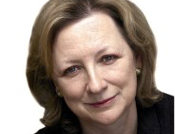Carla Carlisle on The Iron Lady
Anyone who lived through the Thatcher years will realise while watching The Iron Lady that we all suffer from a kind of dementia: we've forgotten the sheer horror of the sectarian violence


The vocabulary is one I've acquired: the cloakroom loo. When I came here as a bride, the throne like loo was in its own small room, but the basin, large enough to bath a baby, was in the passage, in the style of gun rooms and hunting lodges.
The taps were encrusted with the lime of ages and the porcelain was streaked by years of slow drips. On the marble shelf above sat a row of ivory brushes, engraved with initials and crests that had faded with use and time. I took against this sink. It was too masculine, too sordid-bristles stiff and brown with age and hair oil, linen towels limp and forlorn-and too public. I bought a shiny, characterless version and installed it inside the cloakroom.
Which is not a cloakroom, of course. No cloaks hang there, only pictures. On two walls hang photographs that span a century of the Harrow 1st XI, with names written in beautiful script, names that recur with each generation (Buxton, Barclay, Carlisle, McCorquodale). And on the third wall, another set of photographs, equally repetitive and masculine. It's the Whips' Office, in the late 1980s, a blur of men, distinguished mainly by varieties of height and hairlines. Seated in the middle of each photograph, looking immaculate, elegant and remarkably like Meryl Streep, is their leader, Margaret Thatcher.
Fished these photos out from the attic a few years ago because they seemed like a quirky souvenir of history, kitsch even: the female star in a chorus line of obedient suits. And then I never looked at the photographs again. The cloakroom still feels like the ‘gents' to me, as masculine and impenetrable as the Whips' Office, but I remembered the images last week as I watched The Iron Lady. I tried to persuade my husband to go with me. After all, he was one of the obedient suits, swept into Parliament in 1979 with a majority of 600 votes, but he refused. He hated the whole idea of a film portraying the Prime Minister as an old lady who has lost her mind.
‘A ruthless invasion of privacy, a lack of respect,' he grumped. Sitting in the dark, however, I missed him. Throughout the film, I wanted to ask him questions. Did Mrs Thatcher ever wear a hat in the Commons? (No.) Was she in the Commons underground car park when Airey Neave's car was blown up by the IRA? (No.) But The Iron Lady isn't a documentary. It's a drama and, at its best, it directs you towards the greater truth. It's also been described as a brave and brilliant film about that most taboo subject, dementia.
The viewer travels down the road of history via the flashbacks and faded memories of the former Prime Minister. More compelling, however, will be the realisation to anyone who lived through the Thatcher years that we all suffer from a kind of dementia. We've forgotten the sheer horror of the years when the IRA was as brutal as the sectarian bombers in Iraq and Afghanistan are today. We've forgotten Airey Neave and Ian Gow, forgotten how close the IRA came to killing the Prime Minister in Brighton. Who, indeed, can remember the names of anyone killed in that bombing? We've also forgotten how divided the country was during those years. In the fog of history, Mrs Thatcher is remembered as a divisive figure, but she came to power in a divided country.
Did the miners' strike, the doomed Poll Tax, deepen those divisions or simply make them more obvious? Although Miss Streep is mesmerising, the great strength of The Iron Lady isn't in the acting. The real achievement is how the heroine's flashbacks trigger our own memories, both triumphant and tragic. At a time when the leaders in Westminster are (again) all sons of privilege, it's useful to remember the leader who pene-trated that masculine and class enclave. Margaret Thatcher is a part of our lives and time. She was flawed and she was remarkable. It's worth remembering.
Sign up for the Country Life Newsletter
Exquisite houses, the beauty of Nature, and how to get the most from your life, straight to your inbox.
* Subscribe to Country Life and save up to 41%
Country Life is unlike any other magazine: the only glossy weekly on the newsstand and the only magazine that has been guest-edited by HRH The King not once, but twice. It is a celebration of modern rural life and all its diverse joys and pleasures — that was first published in Queen Victoria's Diamond Jubilee year. Our eclectic mixture of witty and informative content — from the most up-to-date property news and commentary and a coveted glimpse inside some of the UK's best houses and gardens, to gardening, the arts and interior design, written by experts in their field — still cannot be found in print or online, anywhere else.
-
 380 acres and 90 bedrooms on the £25m private island being sold by one of Britain's top music producers
380 acres and 90 bedrooms on the £25m private island being sold by one of Britain's top music producersStormzy, Rihanna and the Rolling Stones are just a part of the story at Osea Island, a dot on the map in the seas off Essex.
By Lotte Brundle
-
 'A delicious chance to step back in time and bask in the best of Britain': An insider's guide to The Season
'A delicious chance to step back in time and bask in the best of Britain': An insider's guide to The SeasonHere's how to navigate this summer's top events in style, from those who know best.
By Madeleine Silver